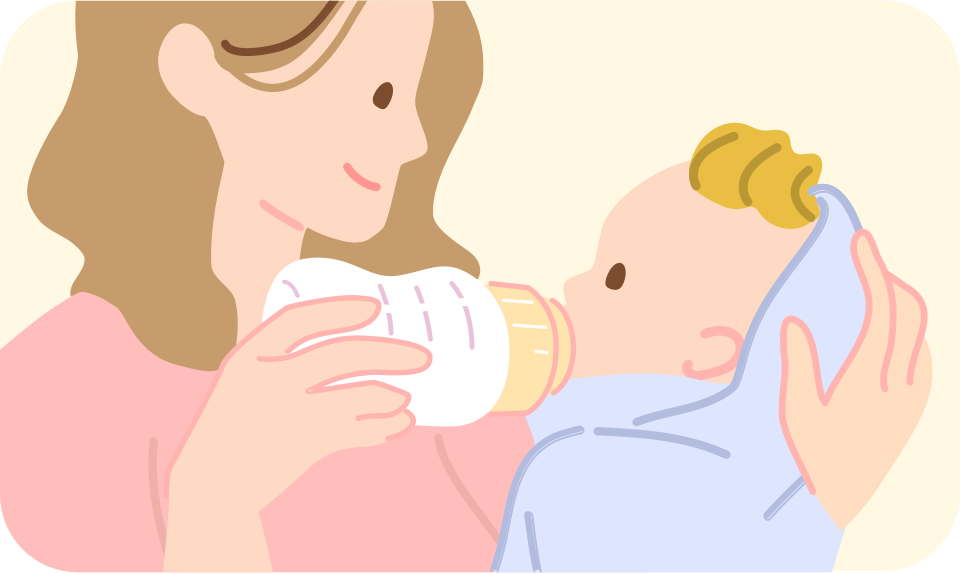Due to maintenance, rewards points for receipt uploads will be delayed. Thank you for your patience!

Paced bottle feeding offers a controlled approach to feeding infants, to help avoid overfeeding. Discover Enfamil's step by step guide on paced bottle feeding.
Paced bottle feeding has gained recognition as an effective method for feeding babies, especially for those transitioning from breastfeeding to bottle feeding or for babies who need more regulated feeding patterns. In this quick guide, we’ll show you how paced bottle feeding can work for you!
Paced feeding involves a methodical approach to bottle feeding that mimics the natural rhythm and pace of breastfeeding. It focuses on being in tune with your baby’s hunger cues in order to create a more natural pace of feeding, which may promote better digestion, and reduce the likelihood of excessive gas and/or overfeeding. You can practice paced feeding whether you’re making formula for your baby or feeding them breastmilk.
By allowing babies to control the flow of milk, paced feeding helps reduce the likelihood of overfeeding, which could lead to discomfort, spitting up, and unnecessary weight gain.
Paced feeding may help lessen gas, upset stomach, bloating, and choking while feeding, as it allows babies to swallow at their own pace, minimizing air intake and promoting proper digestion.
For babies transitioning from breastfeeding to bottle feeding, paced feeding provides a familiar and comfortable method that closely resembles breastfeeding, which may ease the transition and may reduce the likelihood of feeding difficulties.

In this position, you sit your baby up in your lap, giving the head and neck plenty of support by gently letting the baby's head rest in your palm with additional support with your middle finger and thumb. On your other hand, you'll be holding the bottle perpendicular to the baby’s body, pulling back and forth very slightly to encourage your baby to suck.
Every few moments, your baby will want to take a short break–simply leaning them forward to let the milk run back into the bottle. If the nipple of the bottle falls out of the mouth, that’s okay. When your baby is ready to restart or re-latch, encourage them to open wide!

In the semi-upright position, cradle your baby in your arm, supporting the head with the inside of your arm. Partially fill the bottle with milk, and tip the bottle away from your baby whenever you need to give them a break. Try not to wiggle the bottle so that your baby can maintain control of how much they want to feed.
Choose a smaller bottle with a slow-flow nipple to give you better control of the rate of milk flow.
Be sure to support your baby’s head and neck. When your baby shows hunger cues, you can tickle the lips so that they will open their mouth nice and wide.
Hold the bottle so that your baby has to suck to get at the milk–this will encourage them to eat only as long as they’re hungry!
Allow your baby to suck on the nipple without milk initially, then tip the bottle only halfway to fill the nipple. Feed for three to five steady swallows, then take a break – this is the key to paced feeding. Your baby can return to feeding as often as they like.
Continue tipping the bottle for three to five swallows at a time, pausing periodically to allow the baby to regulate their intake and avoid overfeeding.
For additional support and resources on infant feeding and development, explore Enfamil Family Beginnings® , a program designed to provide guidance and assistance to parents navigating the journey of early parenthood. From bottle and breastfeeding guidance to opportunities to earn points towards formula rewards and sweepstake entries, there’s something for everyone in this free-to-enter program!
All information on Enfamil, including but not limited to information about health, medical conditions, and nutrition, is intended for your general knowledge and is not a substitute for a healthcare professional's medical identification, advice, or management for specific medical conditions. You should seek medical care and consult your doctor or pediatrician for any specific health or nutrition issues. Never disregard professional medical advice or delay seeking medical treatment, care, or help because of information you have read on Enfamil.